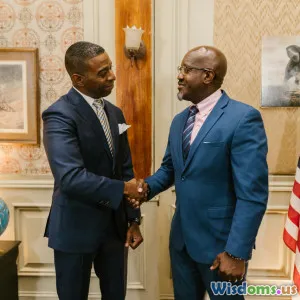
Real Stories: Successful Communication in Diverse Contexts
7 min read Explore powerful real-life examples of successful communication across diverse contexts and cultures. (0 Reviews)
Real Stories: Successful Communication in Diverse Contexts
Communication acts as the nervous system connecting individuals, institutions, and societies. In today's interconnected world, the greatest challenge is often communicating successfully across diverse cultural, professional, and social boundaries. But what does truly effective communication in diverse contexts look like? Beyond theoretical frameworks and platitudes, real-world narratives provide invaluable lessons and inspiration.
This article explores compelling stories of communication triumphs in multicultural settings—from boardrooms to humanitarian projects—and distills practical insights for readers seeking to enhance their own cross-contextual communication.
Defining Success in Communication Across Diversity
Before diving into stories, it’s essential to understand the criteria defining 'success' in communication. Success goes beyond message clarity or language fluency; it encompasses mutual understanding, respect, relationship building, and actionable results within varying cultural norms and environments.
- Mutual Understanding: The receiver not only hears but truly comprehends the meaning as intended.
- Respectfulness: Communication honors cultural values and perspectives.
- Efficacy: It achieves desired outcomes—be it collaboration, conflict resolution, or knowledge exchange.
Each real-world example in this article embodies these principles in distinct ways.
Story 1: Navigating Tokyo’s Corporate Culture Without Losing Your Voice
A leading US tech company expanded into Japan, aiming to penetrate the local market. Initially, meetings with Japanese partners stalled; American managers perceived the silence as disengagement, while Japanese counterparts found their direct style off-putting.
The Breakthrough
After engaging a cultural consultant, the team learned Japan’s consensus-driven decision-making and value on harmony (wa) shaped their communication. American managers adapted by fostering more group discussions, ensuring every voice was invited respectfully.
Outcome
Within six months, joint projects reached new agreements faster, backed by mutual trust. The American team’s humility and genuine listening cultivated relationships that transcended business transactions.
Lessons
- Understanding indirect communication styles expands effective dialogue.
- Patience in adapting behaviors fosters enduring partnerships.
Story 2: Grassroots Dialogue Healing Post-Conflict Rwanda
Twenty-five years after the genocide, reconciliation efforts needed effective communication to bridge deep ethnic divides. A local NGO launched dialogue sessions where survivors and perpetrators spoke openly—despite high emotional stakes.
Strategies Employed
- Creating safe spaces free of judgment.
- Facilitated story-sharing emphasizing empathy.
- Incorporating traditional conflict resolution frameworks.
Results
Communities reported reduced violence and increased cooperation in rebuilding infrastructure and education initiatives. The shared humanity revealed in conversations enabled healing firsthand.
Insights
- Emotional intelligence and patience are critical in sensitive cultural contexts.
- Storytelling can transform divisive narratives into mutual understanding.
Story 3: Remote Teams Mastering Multicultural Collaboration in the COVID Era
A global consulting firm’s shift to remote work magnified cultural communication gaps. With members from over 15 countries, misunderstandings arose in written communication and meeting etiquette.
Intervention
The firm instituted cultural competence workshops focusing on:
- Time-zone sensitivity and scheduling etiquette.
- Language simplification avoiding idioms.
- Cultivating active listening and inclusive questioning.
Impact
Internal surveys showed a 30% increase in perceived team cohesion and reduced project delays attributed to miscommunication.
Takeaway
In virtual environments, explicit efforts to recognize diversity enhance collective intelligence and operational efficiency.
Story 4: Health Campaigns Winning Hearts with Linguistic Precision and Cultural Respect
In rural India, a vaccination campaign initially struggled due to misinformation and distrust rooted in cultural beliefs.
Approach
Health workers partnered with local storytellers and conducted outreach in native dialects. Visual aids incorporated culturally relevant symbolism to dispel myths.
Outcome
Vaccination rates increased by 40% within a year, preventing infectious disease outbreaks.
What We Learn
- Tailored communication that honors language and culture improves message acceptance.
- Trust-building requires integrating local knowledge and voices.
Universal Strategies from These Stories
Across these diverse contexts, successful communication hinged on several key principles:
- Cultural Awareness: Invest time in understanding the cultural fabric shaping communication norms.
- Empathy and Listening: Actively listening validates others’ perspectives and builds rapport.
- Adaptability: Flexibility in style and medium depending on context and audience.
- Patience: Effective communication is a process, especially where cultural differences exist.
- Inclusivity: Ensuring every stakeholder’s voice is heard fosters ownership and smoother collaboration.
Conclusion: Embracing Diversity as an Enrichment, Not a Barrier
These real stories reinforce that diverse contexts are not obstacles but opportunities for enriched communication. When individuals and organizations commit to deeper cultural understanding and empathetic exchange, they unlock collaboration, innovation, and healing that homogeneous groups may never achieve.
In practical terms, anyone—be it a leader, educator, or community member—can draw inspiration from these exemplars. Begin with curiosity, embrace difference as a strength, and pursue communication not as a one-way message but as a shared journey. The world grows smaller, yet richer, as diverse narratives and voices converge in successful connection.
Let these stories inspire you to transform your communication approach, honoring diversity not only as circumstance but as a powerful catalyst for shared success.
References
- Gudykunst, W.B. (2003). Cross-Cultural and Intercultural Communication. Sage Publications.
- Lewis, R.D. (2018). When Cultures Collide: Leading Across Cultures. Nicholas Brealey Publishing.
- Interviews and insights from cultural consultants at Intercultural Dynamics (company archives, 2022).
- Rwanda Reconciliation Efforts, United States Institute of Peace Reports, 2021.
- Global Remote Work Survey, McKinsey & Co., 2021.
Embrace the art of communication as your greatest bridge across human diversity.
Rate the Post
User Reviews
Popular Posts



















